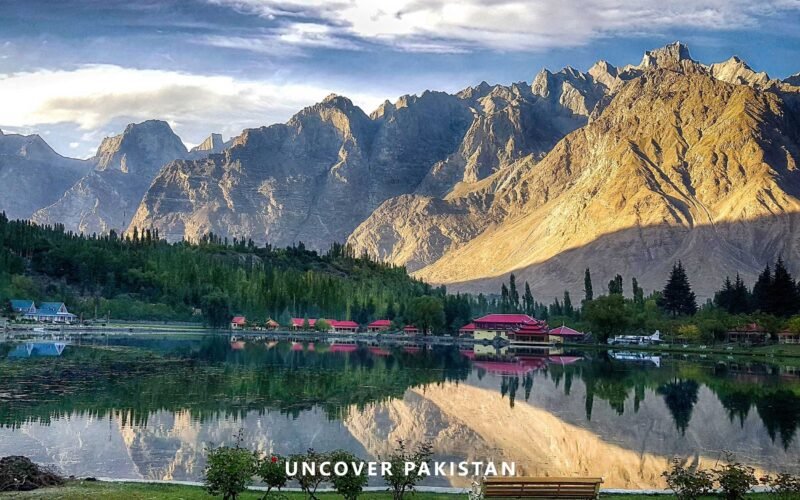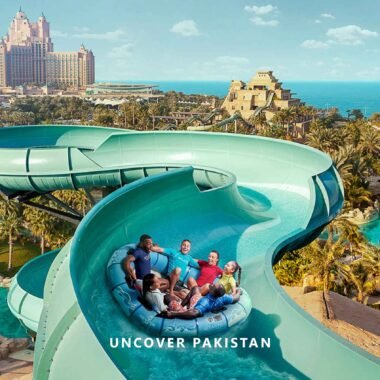Pakistan is a country of breathtaking landscapes and rich cultural heritage. From towering mountain peaks and serene valleys to ancient ruins and vibrant cities, it offers a diverse array of destinations for travelers. Whether you love nature, history, or adventure, Pakistan’s top attractions promise an unforgettable journey. Below are the top 10 places to visit in Pakistan, each with its own unique allure and story.
Table of Contents
#1 Hunza Valley
Hunza Valley is a mountainous paradise in Gilgit-Baltistan known for its stunning high-altitude scenery and warm hospitality. Tucked between the Himalayas and the Karakoram Range, this fertile valley is dotted with terraced fields and orchards of apricots and cherries. The turquoise Hunza River winds through villages like Karimabad, where the ancient Baltit Fort overlooks the valley. Travelers are greeted with panoramic views of snow-capped peaks such as Rakaposhi and Ultar Sar, often called a glimpse of heaven on earth.
Hunza’s natural beauty is matched by its unique culture. The local people, famed for their friendliness and longevity, welcome visitors with open arms. Adventurers can explore nearby gems like Attabad Lake (formed by a landslide in 2010, now a popular boating spot) and the striking Passu Cones rock formations along the Karakoram Highway. Wildlife enthusiasts might even spot a Himalayan ibex or the elusive snow leopard in the surrounding mountains. Whether you’re trekking to remote glaciers or enjoying a cup of tea under blossoming apricot trees, the Hunza Valley offers a truly magical experience.
#2 Swat Valley
Swat Valley, in Khyber Pakhtunkhwa (KPK) province, is often nicknamed the “Switzerland of the East” for its lush alpine scenery and pleasant climate. This picturesque valley is characterized by green meadows, forests, and the Swat River meandering through high mountains. Popular towns like Mingora and Kalam serve as bases for exploring Swat’s natural wonders, which include sparkling lakes and waterfalls. Malam Jabba, Pakistan’s premier ski resort, is also located here, offering skiing in winter and hiking in summer.
After overcoming challenges in the late 2000s, Swat has revived as a peaceful, fairytale-like destination. Visitors can enjoy activities like trekking and trout fishing or simply relax in the cool hill station atmosphere. Swat Valley also carries a rich historical legacy as a center of Buddhism in ancient Gandhara; ruins of Buddhist stupas and monasteries dot the region, adding an archaeological intrigue. With its mix of natural beauty and cultural depth, Swat Valley enchants travelers and is once again one of Pakistan’s most welcoming destinations.
#3 Naran Kaghan Valley
The Naran and Kaghan Valley is a scenic wonderland in the Kaghan region of KPK, known for its dramatic landscapes. This area boasts beautiful rivers, verdant fields, snow-capped peaks, and crystal-clear lakes. The towns of Naran and Kaghan are popular summer retreats, easily accessible by road from Islamabad. Perhaps the crown jewel of this valley is Lake Saif-ul-Muluk, a glacial lake surrounded by mountains, famous for its emerald waters and a local legend about a prince and a fairy.
Tourists flock to Naran Kaghan Valley each year to escape the summer heat and immerse themselves in nature. You can take jeeps up to Babusar Pass for sweeping views or camp by alpine lakes under starry skies. Hiking trails lead to idyllic spots like Lulusar Lake and Siri Paye Meadows, where wildflowers bloom in abundance. The valley’s hospitality infrastructure has grown, with many hotels and campsites catering to visitors. Whether you’re seeking adventure or tranquility, Naran Kaghan’s breathtaking vistas make it a must-visit destination for nature lovers.
#4 Kalash Valleys
Hidden in the mountains of Chitral in Khyber Pakhtunkhwa, the Kalash Valleys are a world apart in terms of culture and scenery. Consisting of three main valleys (Bumburet, Rumbur, and Birir), this area is home to the Kalash people, one of Pakistan’s smallest and most unique ethnoreligious communities. The Kalash practice an ancient polytheistic religion with roots in animism, and their society is known for vibrant festivals, wooden hillside villages, and brightly embroidered traditional dress.
Visiting the Kalash Valleys offers a fascinating cultural experience amid a picturesque landscape of lush greenery and flowing streams. The people are incredibly welcoming to outsiders, and tourists often get to witness their seasonal festivals filled with music and dancing. The valleys themselves are stunning, surrounded by rugged mountains that turn golden in autumn. A trip to Kalash is like stepping back in time – it’s an immersive journey that showcases Pakistan’s cultural diversity and natural beauty in equal measure.
#5 Lahore
Lahore is the cultural heart of Pakistan and a city brimming with history, art, and cuisine. As the capital of Punjab province, Lahore has been the center of various empires, from the Mughal dynasty to the British Raj, and its architecture reflects this rich past. In the walled old city, you’ll find the magnificent Badshahi Mosque (built in 1673) and the neighboring Lahore Fort, both UNESCO World Heritage Sites exemplifying grand Mughal architecture. The intricate Wazir Khan Mosque and the sprawling Shalimar Gardens (another UNESCO site) are other must-see historic attractions.
Beyond monuments, Lahore offers an immersive cultural experience. The city’s bustling bazaars like Anarkali and the food street of Gawalmandi are famous for mouthwatering Punjabi food – from fragrant biryanis to delectable street snacks. Museums such as the Lahore Museum showcase ancient Gandharan art and Pakistani heritage. In the evenings, families throng to Minar-e-Pakistan and Jilani Park for leisure. Lahore’s old-world charm combined with its modern vibrancy truly captures the slogan “Lahore Lahore hai” (Lahore is Lahore) – meaning it is incomparable. For anyone interested in history and culture, Lahore is an essential stop in Pakistan.
#6 Islamabad
Pakistan’s capital, Islamabad, is a city known for its scenic beauty, serenity, and modern urban planning. Nestled against the backdrop of the Margalla Hills, Islamabad is lush with greenery and clean wide roads – a stark contrast to many other South Asian capitals. One of its iconic landmarks is the Faisal Mosque, an architectural marvel that was once the largest mosque in the world. With its vast white tent-like design and four sharp minarets, Faisal Mosque stands impressively at the foot of the hills and can be seen from across the city.
Visitors to Islamabad enjoy a mix of nature and sights. The Margalla Hills offer hiking trails and panoramic viewpoints like Daman-e-Koh and Pir Sohawa, where you can overlook the city especially at sunset. The city also hosts the Pakistan Monument, a flower-petal shaped national monument and museum, and nearby historic Saidpur Village. Islamabad’s atmosphere is calm and family-friendly, with parks and lakes (such as Rawal Lake) for recreation. Its central location makes it a gateway for excursions to the north. Modern yet close to nature, Islamabad leaves an impression as one of the most beautiful and well-organized cities in Pakistan.
#7 Mohenjo-Daro
For history enthusiasts, Mohenjo-daro is one of the most significant archaeological sites in South Asia. Located in Sindh province near the Indus River, Mohenjo-daro was a major city of the ancient Indus Valley Civilization around 2500 BCE. Walking through its ruins, you are literally stepping into a 4,500-year-old city. Excavated remains reveal a surprisingly advanced urban layout, with a grid-pattern of streets, brick houses, covered drainage systems, and the famous “Great Bath” which might have been used for ritual purification.
Mohenjo-daro’s scale and preservation are astonishing – it’s estimated that around 40,000 people once lived here. Now a UNESCO World Heritage Site, it offers a glimpse into one of the world’s earliest urban centers. The name “Mohenjo-daro” means “Mound of the Dead,” but the civilization was far from primitive in its heyday. Visitors can see the remnants of city walls, wells, and marketplaces, and even a large granary. On-site museums display artifacts like pottery, tools, and the famous bronze statuette of the Dancing Girl. Exploring Mohenjo-daro is a surreal experience that highlights Pakistan’s importance as a cradle of ancient civilization.
#8 Makli Necropolis (Thatta)
Just outside the town of Thatta in Sindh lies the Makli Necropolis, one of the largest graveyards in the world and a site of haunting beauty. Spread over 10 square kilometers, this UNESCO World Heritage Site contains perhaps up to a million tombs and mausoleums, some dating back to the 14th century. Here lie buried royalty, Sufi saints, and scholars from centuries past, commemorated by magnificent tomb structures. The funerary architecture is a blend of Islamic, Persian, and Sindhi styles – carved sandstone graves adorned with intricate geometric patterns and inscriptions that have withstood the test of time.
Walking through Makli is a journey through history and art. Notable are the massive stone canopies and brightly glazed tile work on certain tombs, reflecting the craftsmanship of bygone eras. The atmosphere is quiet and reverential; as you wander among the ornate graves, it’s easy to feel a profound connection to those who lived long ago. While in Thatta, it’s also worth visiting the nearby Shah Jahan Mosque, built by the Mughal emperor Shah Jahan. This 17th-century mosque features over 90 domes decorated with exquisite blue and white tiles, and boasts acoustics so masterful that a person speaking at one end of the hall can be heard at the other. Together, Makli Necropolis and the Shah Jahan Mosque make Thatta a must-visit for lovers of history and architecture.
#9 Hingol National Park (Balochistan)
Hingol National Park is a vast and otherworldly landscape located along the Makran Coastal Highway in Balochistan. Covering about 6,100 square kilometers near the Arabian Sea, it is Pakistan’s largest national park, known for its diverse ecosystems ranging from arid mountains to coastal wetlands. Travelers driving through Hingol are treated to surreal vistas of wind-carved rock formations. Two famous natural sculptures stand out: the Princess of Hope, a rock formation resembling a poised statue, and the so-called Balochistan Sphinx, both shaped by millennia of erosionen.wikipedia.org. These unique rock formations have been attracting tourists and photographers, especially since the coastal highway improved access to the area.
Aside from geology, Hingol is a haven for wildlife. The park is home to ibex, urial sheep, chinkara gazelles, and even marsh crocodiles near the Hingol River estuary. If you’re lucky, you might spot a golden jackal or a flock of migratory birds along the coast. The landscape itself ranges from towering cliffs and mud volcanoes to serene beaches on the Arabian Sea. Many describe parts of Hingol as looking like a Martian or lunar terrain. Visiting this park is often combined with a road trip from Karachi, stopping at the Kund Malir beach for a picnic and marveling at the rugged beauty of Balochistan. For adventurous souls and nature enthusiasts, Hingol National Park offers a truly unique slice of Pakistan’s natural heritage.
#10 Skardu & Deosai Plains
Skardu is the gateway to Pakistan’s most epic mountain adventures. Located in Gilgit-Baltistan at the confluence of the Indus and Shigar rivers, Skardu town is surrounded by some of the world’s highest peaks in the Karakoram Range. Mountaineers use Skardu as the starting point for expeditions to K2, the world’s second-tallest mountain, and other famous peaks. For the average traveler, Skardu offers its own delights: the peaceful Shangrila Lake (Lower Kachura) with its iconic red-roofed resort, the turquoise Satpara Lake, and the historic Kharpocho Fort overlooking the valley.
One of the must-see natural wonders near Skardu is the Deosai National Park, often called the Deosai Plains. Sitting at an elevation of around 4,114 meters (13,500 ft), this high-altitude plateau is the second-highest in the world, earning it the nickname “Roof of the World.” During summer, Deosai comes alive with wildflowers and butterflies, and it’s sometimes referred to as the “Land of Giants” due to its vast expanse. Visitors can camp by alpine lakes and possibly spot the Himalayan brown bear, which the park was established to protect. Access to Deosai is typically from June to September, as heavy snowfall cuts off the area in winter. Between Skardu’s dramatic landscapes and the serene beauty of Deosai Plains, this region showcases the raw, awe-inspiring grandeur of Pakistan’s north.
Conclusion
Pakistan is blessed with an incredible mix of natural beauty, cultural heritage, and historical treasures. From the towering peaks of Hunza and Skardu to the vibrant streets of Lahore and the ancient ruins of Mohenjo-daro, each destination offers a unique experience. Whether you seek adventure in the mountains, peace in serene valleys, or a deep dive into centuries-old history, Pakistan has it all.
With improving infrastructure and warm hospitality, exploring these top destinations has never been easier. Every journey reveals something new, be it breathtaking landscapes, unique traditions, or unforgettable moments. Pakistan is truly a traveler’s paradise, waiting to be discovered.
Frequently Asked Questions
Hunza Valley, Skardu, and Swat Valley are often considered the most beautiful, each offering unique scenery.
Yes, especially in major tourist spots. Always follow local advice and basic safety measures.
Spring (April–June) and autumn (Sept–Nov) offer the best weather for most regions.
Lahore, Hunza, Naran Kaghan, Swat, and Mohenjo-daro attract the highest number of visitors.
Most travelers require a visa, but Pakistan offers an e-visa system for many countries.
Dress modestly, especially in rural and religious areas. Lightweight clothes for summer and warm layers for the mountains.




